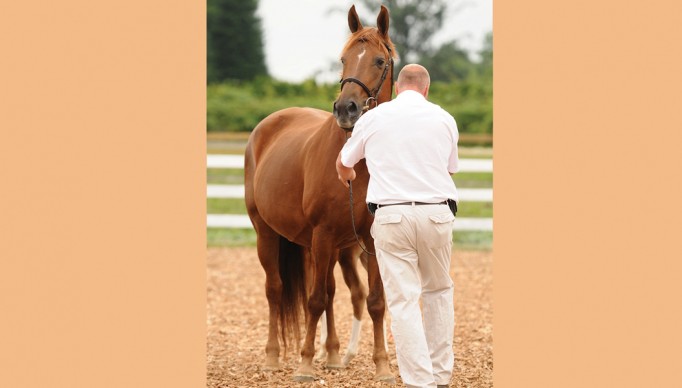It is, however, a necessary skill to teach young horses, as there will be countless occasions where they will have to back up obediently and straight, such as out of trailers, during a dressage test, into wash stalls, and away from trouble (or off your foot!).
Armin Arnoldt offer some tips for teaching (or re-training) a horse to back up properly:
“Training to back up should start when they’re babies. With the little ones I go into the stall with them, because it provides the confines and the walls to use as an aid for straightness. With their halter and lead rein on, place them beside the wall and ask them to back up. You can either stand directly in front of the horse, or you can also do it from the side, which creates a channel between you and the wall. If you stand in front be very aware, though, especially if you are unfamiliar with the horse. Pull downward toward the horse’s chest, which puts pressure on the nose and poll. Put a hand on the chest and give a light push. If he backs up even one or two steps, that’s perfect. Stop, praise him and allow him to come forward. This is one time where you might even offer treats (although I’m not super on treats). They understand a calm, praising voice – that’s often enough.
If you want them to go straight, start straight to begin with. If they start wriggling, stop, come forward a few steps to get the idea of straightness, then back up a few steps. At first I would say straightness is not a big issue as long as they back up. The straightness will come; you won’t get it in one session.
A crop can be used to create an extension of your arm – it is not meant to ever punish the horse, just as a visual aid. Use the end of the crop to push gently into the chest as you move toward the horse.
If you have a horse come in that just doesn’t want to back up, the first thing I would do is check with my veterinarian. Injuries in the hind leg, stifle, or back problems makes the horse incapable of backing, as he may be in pain. It’s important to know every horse’s history.
Some horses back up willingly, and some are quite resistant. I’ve had horses that were not so good backing up in halter, so I put a bridle on them instead. Stand in front and ask using even pressure on the reins with both hands – even open your arms a little bit and back them up. That will keep them quite straight, their neck will stay straight, and you have a winner. It is almost like they are on the bit; it should even look similar.
For horses in the early stages of their under-saddle training, you can ask them to back up from the ground first to see how pliable they are before you try with a rider on. Backing up is a big obedience and trust issue for a horse – that’s why it’s part of the dressage test.
Never use backing up as a punishment! People yank on their horses and back them up for 10 metres as if they’ve accomplished something, but it does nothing for the horse.
Don’t make an hour’s lesson out of backing up, either. It’s a quick daily thing – you can do it in the barn, and when you lead them out to the paddock. Youngsters have a short attentions span and you want everything to be fun for them.”
Dreamscape Farm in Langley, BC, is owned and managed by Armin and Jennifer Arnoldt. It is the home of over a dozen licensed Westfalian, Oldenburg, Hanoverian and Dutch Warmblood stallions, including Freestyle, Farscape DSF and Banderas. Visit their website at www.dreamscapefarm.com.

